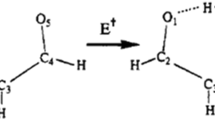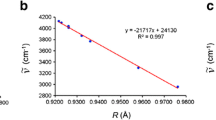Conclusions
The main conclusion derived from this work is that the H bond in all three FHF−, FHFH, and HFHFH+ systems is a three-centered, two-electron, covalent chemical bond formed at the expense of 2a 1g (2a 1) MO bonding. The 1a 1g MO bonding has little effect on H-bond stabilization. Thus the H bond is a one-orbital chemical bond with its formation corresponding, to that of a three-centered MO, as distinguished from molecules bonded by a two-centered MO (e.g., F2 or HOOH [41]; hence the H bond is much weaker. The uniqueness of the H bond lies in its being the weakest covalent bond. It is precisely the covalent nature of the H bond that gives it its characteristic properties, i.e., saturability and strict compliance to structural requirements. In addition, the low dissociation barrier makes it easy to control the H bond under mild conditions, which is very important in biological systems.
Similar content being viewed by others
Literature Cited
J. A. Pople, Faraday Discuss. Chem. Soc.,73, 7 (1982).
I. P. Gragerov and V. K. Pogorelyi, The Hydrogen Bond and Rapid Proton Exchange [in Russian], Naukova Dumka, Kiev (1978).
V. P. Bulychev and N. D. Sokolov, in: The Hydrogen Bond [in Russian], N. D. Sokolov (ed.), Nauka, Moscow (1981), p. 10.
P. Schuster, “The fine structure of the hydrogen bond”, in: Intermolecular Interactions: From Diatomics to Biopolymers, B. Pullman (ed.), Wiley, New York (1977).
C. A. Coulson, Research (London),10, 49 (1957).
J. N. Murrell, Chem. Br.,5, 107 (1969).
P. Kollman, J. Liebman, and L. C. Allen, J. Am. Chem. Soc.,92, 1142 (1970).
I. G. Kaplan, Introduction to the Theory of Intermolecular Interactions [in Russian], Nauka, Moscow (1982) p. 74.
P. A. Kollman and L. C. Allen, Chem. Rev.,72, 283 (1972).
L. C. Allen, J. Am. Chem. Soc.,97, 6921 (1972).
J. D. Dill, L. C. Allen, W. C. Topp, and J. A. Pople, J. Am. Chem. Soc.,97, 7220 (1975).
P. Kollman, J. McKelwey, A. Johanson, and S. Rothenberg, J. Am. Chem. Soc.,97, 955 (1975).
J. E. Del Bene, J. Phys. Chem.,82, 1341 (1982).
P. N. Swepston, S. Colby, H. L. Sellers, and L. Schafer, Chem. Phys. Lett.,72, 364 (1980).
A. Beyer and A. Karpfen, Chem. Phys.,64, 343 (1982).
M. D. Newton and N. R. Kestner, Chem. Phys. Lett.,94, 198 (1983).
P. A. Kollman, Acc. Chem. Res.,10, 365 (1977).
P. Hobza and K. Zahradnic, Int. J. Quantum Chem.,23, 1 (1983).
Encyclopedic Chemical Dictionary [in Russian], Sov. Entsiklopediya, Moscow (1983), p. 264.
V. V. Minkin and R. M. Minyaev, Usp. Khim.,51, 586 (1982).
B. M. Gimarc, Acc. Chem. Res,7, 384 (1974).
R. M. Minyaev and V. I. Pavlov, Zh. Org. Khim.,18, 1595 (1982).
R. M. Minyaev and V. I. Pavlov, J. Mol. Struct. Theochem.,9, No. 2, 205 (1983).
P. J. Desmeules and L. C. Allen, J. Chem. Phys.,72, 4731 (1980).
T. R. Dyke, B. J. Howard, and W. Klemperer, J. Chem. Phys.,56, 2442 (1972).
D. F. Smith, J. Mol. Spectrosc.,3, 473 (1959).
E. F. Frank and F. Meyer Z. Elektrochem.,63, 577 (1959).
R. Hoffmann, T. A. Albright, and D. L. Thorn, Pure Appl. Chem.,50, 1 (1978).
D. E. Feller, M. W. Schmidt, and K. Ruedenberg J. Am. Chem. Soc.,104, 960 (1982).
W. England and K. Ruedenberg, Theor. Chim. Acta.,22, 196 (1971).
D. A. Dixon, D. A. Kleier, T. A. Halgren, et al. J. Am. Chem. Soc.,99, 6226 (1977).
C. Trindl and O. Sinanoglu, J. Chem. Phys.,59, 65 (1968).
R. Hoffman and J. E. Williams, Jr., Helv. Chim. Acta,55, 67 (1972).
L. L. Lohr, Jr. and R. J. Sloboda, J. Chem. Phys.,85, 1332 (1982).
S. Scheiner, J. Am. Chem. Soc.,103, 315 (1981) J. Chem. Phys.,86, 376 (1982).
S. Scheiner and L. B. Harding, J. Am. Chem. Soc.,103, 2169 (1981).
S. Scheiner, M. Lgorzat, M. Szczesniak, and L. D. Bingham, Int. J. Quantum Chem.,23, 739 (1983).
L. I. Virin, R. V. Dzhagatspanyan, G. V. Karachevtsev, et al., Ion-Molecule Reactions in Gases [in Russian], Nauka, Moscow (1979) p. 15.
Z. Berkovitch-Yellin and L. Leiserowitz, J. Am. Chem. Soc.,99, 6106 (1977).
P. Hobza, H. J. Hofmann, and R. J. Zahradnik, J. Phys. Chem.,87, 573, (1983).
V. I. Minkin, B. Ya. Simkin, and R. M. Minyaev, Theory of Molecular Structures [in Russian], Vysshaya Shkola, Moscow (1979), p. 129.
R. Hoffmann, J. Chem. Phys.,39, 1397 (1963).
R. Ditchfield, W. J. Hehre, and J. A. Pople, J. Chem. Phys.,54, 724 (1971).
W. J. Hehre, W. A. Lathan, R. Ditchfield, et al., Program No. 236, QCPE, University of Indiana Bloomington, Indiana, USA.
Author information
Authors and Affiliations
Additional information
Translated from Zhurnal Strukturnoi Khimii, Vol. 26, No. 2, pp. 13–21, March–April, 1985.
Rights and permissions
About this article
Cite this article
Minyaev, R.M., Orlova, G.V. Covalent nature of the hydrogen bond. J Struct Chem 26, 157–164 (1985). https://doi.org/10.1007/BF00754217
Received:
Issue Date:
DOI: https://doi.org/10.1007/BF00754217




